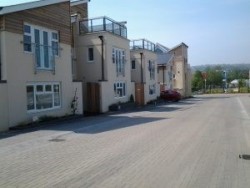Applications of light steel framing range from low-rise housing to multi-storey, multi-occupancy developments, including panelised structural frames, external infill walling systems and fully finished offsite modular construction. The range of building types is indicated by the projects shown in Figures 1 to 4.
Figure 1 – Housing development using light steel framing

Figure 2 – Medium rise development using light steel framing

Figure 3 – Multi-storey light steel framed residential development
The prefabricated wall panels are typically storey-height (i.e. 2.7m to 3.2m) and up to 8m long, depending on transportation and lifting.

Figure 4 – Light steel external walling

Figure 5 – Light steel framing during construction
Both joisted and composite floors often use slim floor beams that are integrated within the floor zone to create more open plan space, which is particularly useful in care homes and in lobby areas. Concrete and steel stairs are generally delivered as part of the light steel package and are integrated into the Building Information Model (BIM) provided by the light steel supplier.

Figure 6 – Light steel framing with composite floors during construction
Figure 7 – Multi-storey light steel framed hotel
The benefits of offsite manufacture and of light steel framing in particular come to the fore in urban residential projects that often involve a mixture of townhouses and larger apartment buildings. Figure 7 shows a city centre hotel using light steel frame construction. The advantages that are sought by the client and contractor are:
• Good sustainability rating based on a range of environmental criteria. Light steel framing can be designed for low U-values and scores A+ or A under the BRE Green Guide. All steel components can be recycled and building extensions can be made easily in the future.
Mixed-use developments
Mixed-use developments generally comprise commercial or retail space at the lower levels and residential units above. A good example is where three- or four-storey housing is constructed over retail space, such as supermarkets in urban areas. The mixed nature of the project may be required for planning reasons or to maximise the return from the land use.
The key requirement is a lightweight super-structure with the ability to span between the transfer beams and to be sufficiently robust to tolerate differential deflections of the supports. Light steel framing has proved to be the perfect solution as it weighs less than 100kg/m2 per floor while achieving spans of up to 6m between beams.
Building Information Modelling (BIM)
The light steel framing industry is leading the way in BIM, which is essential to the manufacturing process and eliminates problems on site, especially with interfaces to other components. In light steel framing, a 3D BIM model of the structure of the building is created in IFC format and is shared with the project architect during the formative stages of design.

Figure 8 – BIM model for light steel framing residential project
From this, the light steel supplier produces panel drawings for their manufacture and also for the other components, such as steel beams and stair units, which are integrated into the model. This enables a consistent geometry and interfaces with other key parts of the building, such as façades and services. Clashes are identified and solved at this stage. The main contractor or project architect would often take on the BIM model and manage subsequent updates so that it is available to the client and facilities manager.
Technical expertise
The Steel Construction Institute (SCI) has over 25 years of R&D experience in the light steel sector and works with leading light steel frame suppliers to prepare design guidance on structural design, acoustics, fire resistance, thermal performance and sustainability. The SCI has published a series of Technical Information Sheets to provide technical guidance to the sector.
Independent SCI product certification is beneficial for new systems to gain market acceptance and is tailored to suit typical light steel construction systems including: Cladding and roofing, External wall systems, Light steel framing and Modular.
Andrew Way - Associate Director - Steel Construction Institute - www.steel-sci.com









